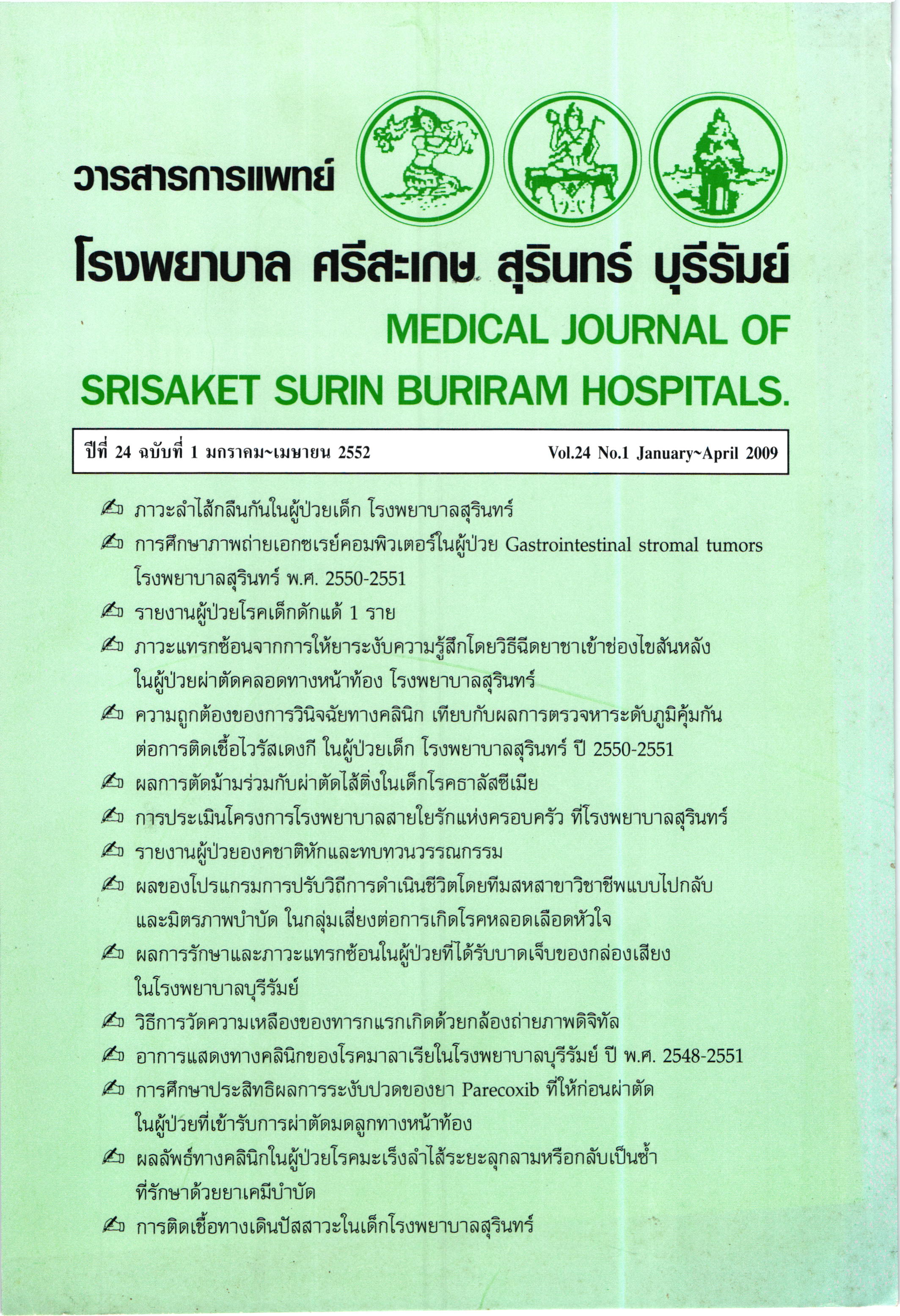การประเมินและแปรผลลักษณะทางอัลตราซาวน์ ของก้อนที่เต้านม โดยใช้Ultrasonographic BI-RADS เปรียบเทียบกับผลพยาธิวิทยา
Main Article Content
บทคัดย่อ
วัตถุประสงค์: เพื่อศึกษาลักษณะทางอัลตราซาวน์ของก้อนที่เต้านมและการแปรผลโดยการใช้ Ultrasonographic BI-RADS เปรียบเทียบกับผลพยาธิวิทยาของก้อนที่เต้านม
วิธีการศึกษา: ทำการศึกษาย้อนหลังผู้ป่วยที่มีก้อนในเต้านมของโรงพยาบาลสุรินทร์ที่ได้รับการตรวจ ด้วยเครื่องอัลตราซาวน์ และมีผลทางพยาธิวิทยายืนยัน จำนวน 29 ราย ตั้งแต่ 1 ตุลาคม พ.ศ. 2550 ถึง 30 กันยายน พ.ศ. 2551
ผลการศึกษา: จากการศึกษาผู้ป่วยที่มีก้อนในเต้านม จำนวน 29 ราย พบว่า มีผู้ป่วยได้รับประเมิน และแปรผลก้อนที่เต้านมโดยรังสีแพทย์เป็น BI-RADS 2, 3, 4 และ 5 มีจำนวน 7, 9, 10 และ 3 รายตามลำดับ ผู้ป่วยที่ถูกจัดอยู่ใน BI-RADS 5 ทั้งหมด และ BI-RAD 4 จำนวน 4 ราย มีผลทางพยาธิวิทยาเป็นมะเร็งเต้านม ผู้ป่วยที่ถูกจัดอยู่ใน BI-RADS 3 จำนวน 3 ราย และ BI-RADS 4 จำนวน 3 ราย มีผลทางพยาธิวิทยาเป็น Fibrocystic changes และผู้ป่วยที่ถูกจัดอยู่ใน BI-RADS 3 จำนวน 6 ราย และ BI-RADS 4 จำนวน 4 ราย มีผลทางพยาธิวิทยาเป็น Fibroadenoma
สรุป: การประเมินและแปรผลลักษณะทางอัลตราซาวน์ของก้อนที่เต้านม โดยใช้ Ultrasonographic BI-RADS มีประโยชน์ในการวินิจฉัย, จำแนกประเภทของก้อน ที่เต้านมว่า น่าจะเป็นมะเร็งหรือเนื้องอกธรรมดา รวมถึงแนวทางในการรักษาร่วม กับศัลยแพทย์ และลดผ่าตัดหรือการตัดชิ้นเนื้อส่งตรวจทางพยาธิวิทยาโดยไม่จำเป็น
Article Details
เอกสารอ้างอิง
2. Lazarus E, Mainiero MB, Schepps B, Koelliker SL, Livingston LS, BI-RADS lexi¬con for US and mammography: Interobserver variability and positive pre¬dictive value. Radiology 2006 May; 239(2):385-91.
3. American College of Radiology. BI-RADS: ultrasound, 1st ed. In: BI-RADS atlas, 4th ed. Reston, VAACR, 2003
4. Elmore JG, Armstrong K, Lehman CD, Fletcher AW Screening for breast cancer. JAMA 2005 Mar 9;293(10):1245-56
5. Crystal P, Strano SD, Shcharynski S, Koretz MJ. Using Sonography to Screen women with mammographically dense breasts. AJR Am J Roentgenol. 2003 Jul; 181(1):177-82
6. Corsetti V, Houssami N, Ferrari A, Ghirardi M et al. Breast screening with ultrasound in women with mammography-negative dense breasts: evidence on incremental cancer detection and false positive, and associated cost. Eur. J Cancer 2008 Mar; 44(4):539-44
7. Obenauser S, Hermann KP, Grabbe E, Applications and literature review of the BI-RADS classification. Eur Radiol 2005 May; 15(5):1027-36
8. Masroor I, Prediction of benignity or malignancy of a lesion using BI-RADS. J Coll Physicians Surg Pak 2005 Nov; 15(11):686-8
9. Costantini M, Belli P, Ierardi C, Frances-chini G et al. Solid breast mass characteris-tisation: use of the sonographic BI-RADS classification. Radiol Med. 2007 Sep; 112(6):877-94
10. Andrea S. Hong, Eric L. Rosen, Mary S. Soo, Jay A. Baker, BI-RADS for sonography: Positive and negative pre-dictive value of sonographic features. AJR 2005;184:1260-1265
11. Park YM, Kim EK, Lee JH, Ryu JH, Han SS, Choi SJ, Lee SJ, Yoon HK, Palpable breast masses with probably benign morphology at sonography: can biopsy be deferred? Acta Radiologica 2008 Dec; 49(10);1104-11
12. Wiratkapun C, Lertsitichai P, Wibulphol-prasert B, Positive predictive value of breast cancer in the lesions categorized as BI-RADS category 5. J Med Asso.Thai 2006 Aug; 89(8):1253-9
13. Leconte I, Fellah L, us and dense breasts: Where do we stand? J Radiol, 2008 Sep; 89(9 Pt 2):1169-79
14. Kang SS, Ko EY, Han BK, Shin JH, Breast US in patient who had microcalcifications with low concern of malignancy on screening mammography. Eur J Radiol, 2008 Aug; 67(2):285-91


